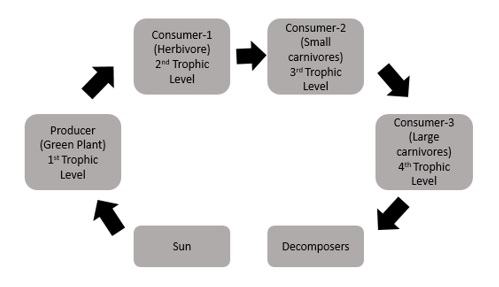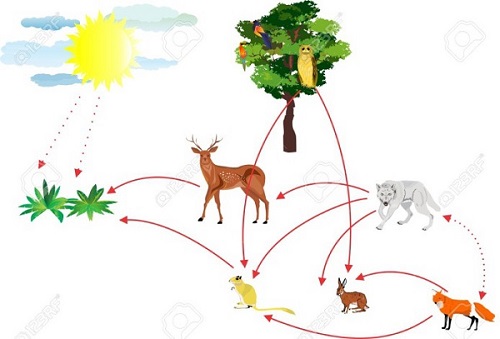
- Environmental Studies - Home
- Environment
- Ecosystem
- Classification of Ecosystem
- Functions Of Ecosystem
- Ecological Pyramid
- Energy Flow in Ecosystem
- Natural Resources
- Water Resources
- Mineral Resources
- Land Resources
- Energy Resources
- Biodiversity
- Biodiversity Hotspots
- Threats to Biodiversity
- Conversation of Biodiversity
- Pollution & Control
- Air Pollution
- Water Pollution
- Noise Pollution
- Soil Pollution
- Solid Waste Management
- Hazardous Waste Management
- Water Waste Management
- Global Environmental Problems
- Ozone Depletion
- Deforestation & Desertification
- International Protocols
- Policy & Legislation
- Air,Water & Forest Acts
- Environmental Impact Assessment
- Towards Sustainable Future
Functions of Ecosystem
The functional attributes of the ecosystem keep the components running together. Ecosystem functions are natural processes or exchange of energy that take place in various plant and animal communities of different biomes of the world.
For instance, green leaves prepare food and roots absorb nutrients from the soil, herbivores feed on the leaves and the roots and in turn serve as food for the carnivores.
Decomposers execute the functions of breaking down complex organic materials into simple inorganic products, which are used by the producers.
Fundamentally, ecosystem functions are exchange of energy and nutrients in the food chain. These exchanges sustain plant and animal life on the planet as well as the decomposition of organic matter and the production of biomass.
All these functions of the ecosystem take place through delicately balanced and controlled processes.
Food Chain
The order of living organisms in a community in which one organism consumes other and is itself consumed by another organism to transfer energy is called a food chain. Food chain is also defined as a chain of organisms, existing in any natural community, through which energy is transferred.
Every living being irrespective of their size and habitat, from the tiniest algae to giant blue whales, need food to survive. Food chain is structured differently for different species in different ecosystems. Each food chain is the vital pathway for energy and nutrients to follow through the ecosystem.

Food chains were first introduced by the African-Arab scientist and philosopher Al-Jahiz in the 9th century and later popularized in a book published in 1927 by Charles Elton.

A food chain starts with a producer such as plants. Producers form the basis of the food chains. Then there are consumers of many orders. Consumers are organisms that eat other organisms. All organisms in a food chain, except the first organism, are consumers.
Plants are called producers because they produce their own food through photosynthesis. Animals are called consumers because they depend on plants or other animals for food to get energy they need.
In a certain food chain, each organism gets energy from the one at the level below. In a food chain, there is reliable energy transfer through each stage. All the energy at one stage of the chain is not absorbed by the organism at the next stage.
Trophic Levels in a Food Chain
Trophic levels are different stages of feeding position in a food chain such as primary producers and consumers of different types.
Organisms in a food chain are categorized under different groups called trophic levels. They are as follows.
Producers (First Trophic Level) − Producers otherwise called autotrophs prepare their food by themselves. They form the first level of every food chain. Plants and one-celled organisms, some types of bacteria, algae, etc. come under the category of Autotrophs. Virtually, almost all autotrophs use a process called photosynthesis to prepare food.
Consumers − At the second trophic level, there are consumers who depend upon others for food.
Primary Consumers (Second Trophic Level) − Primary consumers eat the producers. They are called herbivores. Deer, turtle, and many types of birds are herbivores.
Secondary Consumers (Third Trophic Level) − Secondary consumers based at the third trophic level eat plants and herbivores. They are both carnivores (meateaters) and omnivores (animals that eat both animals and plants). In a desert ecosystem, a secondary consumer may be a snake that eats a mouse. Secondary consumers may eat animals bigger than they are. Some lions, for example, kill and eat buffalo. The buffalo weighs twice as much as the lions do.
Tertiary Consumers (Fourth Trophic Level) − Tertiary consumers are animals eating other carnivores. The secretary bird in Africa and the King Cobra specialize in killing and eating snakes but all snakes are carnivores. The leopard seal eats mostly other carnivores - mainly other seals, squids, and penguins, all of which are carnivores.
Decomposers − Decomposers which dont always appear in the pictorial presentation of the food chain, play an important part in completing the food chain. These organisms break down dead organic material and wastes. Fungi and bacteria are the key decomposers in many ecosystems; they use the chemical energy in dead matter and wastes to fuel their metabolic processes. Other decomposers are detritivoresdetritus eaters or debris eaters.
Understanding the food chain helps us know the feeding interrelationship and interaction between an organism and the ecosystem. It also enables us to know the mechanism of energy flow in an ecosystem.
Food Web
The word web means network. Food web can be defined as a network of interconnected food chains so as to form a number of feeding relationships amongst different organism of a biotic community.
A food chain cannot stand isolated in an ecosystem. The same food resource may be a part of more than one chain. This is possible when the resource is at the lower tropic level.
A food web comprises all the food chains in a single ecosystem. It is essential to know that each living thing in an ecosystem is a part of multiple food chains.

A single food chain is the single possible path that energy and nutrients may make while passing through the ecosystem. All the interconnected and overlapping food chains in an ecosystem make up a food web.
Food webs are significant tools in understanding that plants are the foundation of all ecosystem and food chains, sustaining life by providing nourishment and oxygen needed for survival and reproduction. The food web provides stability to the ecosystem.
The tertiary consumers are eaten by quaternary consumers. For example, a hawk that eats owls. Each food chain ends with a top predator and animal with no natural enemies (such as an alligator, hawk, or polar bear).